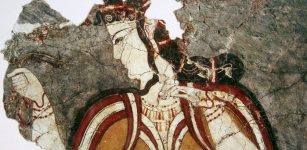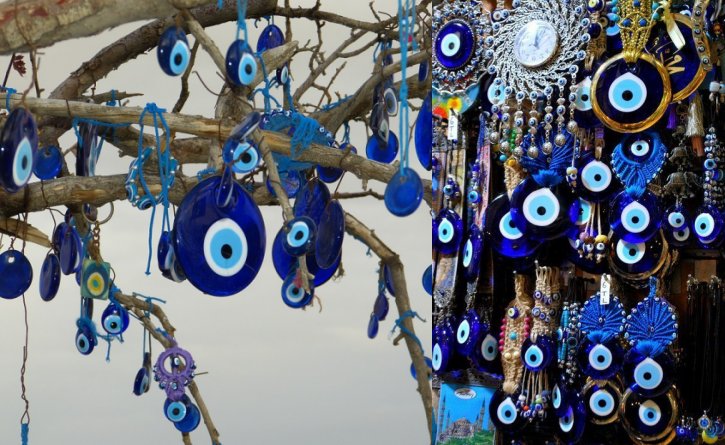Nazar Amulet – Blue Color Wards Off The Evil Eye According To Ancient Belief
Ellen Lloyd - AncientPages.com - Millions of modern people believe in the power of the Evil Eye, just like our ancestors did in ancient times. This belief has nothing to do with that people are afraid of eye contact, but rather of harmful power that comes from emotions such as envy or greed.
Nazar amulets can be bought in many places today.
All across the world it’s possible to stumble upon ancient symbols that are thought to protect against the curse of the Evil Eye. Some of these symbols are very old, but their meaning and purpose have never been erased from history. In ancient times it was believed that blue color was strong protection against the Evil Eye, a magical power that is at least 5,000 years old.
3,000-Year-Old Sumerian Clay Tablet - Oldest Reference To The Evil Eye
As previous discussed on Ancient Pages, the curse of the Evil Eye is an ancient, superstitious and almost universal belief that certain people possess the supernatural power to cause disaster, illness, calamity and even death.
They have an ability to do it with a gaze or stare that gives an unpleasant emotion. The evil eye is widely feared in many parts of the world.
Nazar symbol. Credit: Public Domain
In modern English we have an expression such as “if looks could kill” and we may joke about it, but ancient people took this notion very seriously. The history of the Evil Eye history stretches back to ancient Mesopotamia, Greece, and Rome through to the Bible, Medieval Europe, and the modern day. One of the oldest reference to the Evil Eye comes from Mesopotamia. About 3,000 years ago, Sumerians wrote on a cuneiform tablet that there are water cures against the Evil Eye. The ancient text reads:” The eye ad-gir, the eye a man has…. The eye afflicting man with evil, the ad-gir. Unto heaven is approached and the storms sent to rain.” The next part of the text involves a Sumerian cure. “Seven vases of meal-water behind grinding stones. With oil mix. Upon (his) face apply.”
Hamsa Symbol Protects From Harm Caused By The Evil Eye
To gain a more permanent protection from the Evil Eye, ancient civilizations started using various protection amulets.
Ancient Symbol Hamsa - Read more
One of the most famous symbols protecting against the Evil Eye is called Hamsa. As described on Ancient Pages in a previous article, Hamsa is a universal symbol and we encounter it in many faiths. It is especially popular among Jews and Muslims. The Hamsa is variously known as the Hand of Fatima (Mohammed’s daughter) and the Hand of Merriam (Moses’ sister) suggest, which is why the amulet carries significance to both Jews and Muslims. It is also sometimes referred to as the Hand of Mary representing Mary, mother of Jesus.
Nazar Amulets And Why Blue Color Ward Off The Evil Eye
Many people who fear the Evil Eye buy protection amulets that can be found in many corners of the world. Nazar amulets are especially popular in Turkey, but they can be found in other countries as well.
In Macedonia, Albania, Bosnia and Herzegovina, Bulgaria, Greece, Cyprus, Syria, Lebanon, Israel, Egypt, Armenia, Iran, India, Afghanistan, Pakistan, Iraq and Azerbaijan, Nazar is often hung in homes, offices, cars, children's clothing, or incorporated in jewelry and ornaments. The belief in the curse of the Evil Eye is very much alive.
The belief in the evil eye goes back thousands of years. Read more
The word Nazar derives from Arabic, meaning literally sight or seeing (hence Nazarite, the knowing ones, or Gnostics).
See also:
Eye Of Providence – Powerful, Secret Symbol With Deep Meaning
Vegvisir – Very Old And Sacred Norse Symbol Of Protection And Guidance
12 Ancient Egyptian Symbols Explained
Ancient Symbol Fleur-de-lis: It’s Meaning And History Explained
Nazar is an eye-shaped amulet. A typical Nazar is made of handmade glass featuring concentric circles or teardrop shapes in dark blue, white, light blue and black, occasionally with a yellow/gold edge. Glass beads were produced and widely used in Mesopotamia, Egypt, Carthage, Phoenicia, Persia and the Roman Empire.
The color blue in the Nazar amulet is of particular importance. History reveals many ancient cultures considered blue color to be of divine origin. Ancient Egyptians saw the deep blue color of water as life and blue sky was divine.
Sumerians made many statues of beings who had very big and blue eyes. Like many other ancient civilizations, the Sumerians considered blue eyes to be a sign of gods.
Many ancient civilizations depicted beings with blue eyes. Read more
Also, blue eyes were an unusual color in western Asia. Blue eyes were perceived as having powerful magic, powerful enough even for deflecting the Evil Eye.
Today, some people buy Nazar amulets because of their intriguing appearance and it’s true they are nice to look at, but we should not forget the history behinds this powerful symbol that is at least 5,000 year-old.
Written by Ellen Lloyd – AncientPages.com
Copyright © AncientPages.com & Ellen Lloyd All rights reserved. This material may not be published, broadcast, rewritten or redistributed in whole or part without the express written permission of AncientPages.com and Ellen Lloyd
About the author:
Ellen Lloyd – is the owner of AncientPages.com and an author who has spent decades researching ancient mysteries, myths, legends and sacred texts, but she is also very interested in astronomy, astrobiology and science in general
More From Ancient Pages
-
 Rhodogune Of Parthia Refused To Bath And Comb Her Hair Until She Subdued The Rebels
Featured Stories | Oct 7, 2019
Rhodogune Of Parthia Refused To Bath And Comb Her Hair Until She Subdued The Rebels
Featured Stories | Oct 7, 2019 -
 Mysterious Unknown Caves And Tunnels Discovered Beneath The Olsztyn Castle
Archaeology | Jul 31, 2020
Mysterious Unknown Caves And Tunnels Discovered Beneath The Olsztyn Castle
Archaeology | Jul 31, 2020 -
 European-Made Sealed Bottles Of Cherries Dated To 18th Century Found At Washington’s Mount Vernon
Archaeology | Apr 23, 2024
European-Made Sealed Bottles Of Cherries Dated To 18th Century Found At Washington’s Mount Vernon
Archaeology | Apr 23, 2024 -
 Sculptures Of Kybele, Athena, Hekate, Apollo Unearthed At Hellenistic Site Of Pisidia Antiocheia, Turkey
Archaeology | Oct 15, 2017
Sculptures Of Kybele, Athena, Hekate, Apollo Unearthed At Hellenistic Site Of Pisidia Antiocheia, Turkey
Archaeology | Oct 15, 2017 -
 First Bathrooms Appeared Around 8,000 B.C In Scotland
Ancient History Facts | Dec 11, 2016
First Bathrooms Appeared Around 8,000 B.C In Scotland
Ancient History Facts | Dec 11, 2016 -
 2,000-Year-Old Celtic Dice Discovered In Poland
Archaeology | Oct 11, 2023
2,000-Year-Old Celtic Dice Discovered In Poland
Archaeology | Oct 11, 2023 -
 82 Mysterious 3,000-Year-Old Pits Discovered In Sweden – Bronze Age Cooking Pits And Ancient Ceremonial Center?
Archaeology | Jun 13, 2017
82 Mysterious 3,000-Year-Old Pits Discovered In Sweden – Bronze Age Cooking Pits And Ancient Ceremonial Center?
Archaeology | Jun 13, 2017 -
 Amergin: First Druid And ‘Wondrously Born’ Son Of Mil, Founder Of Poetry, Was Judge In Irish Mythology
Celtic Mythology | Mar 3, 2022
Amergin: First Druid And ‘Wondrously Born’ Son Of Mil, Founder Of Poetry, Was Judge In Irish Mythology
Celtic Mythology | Mar 3, 2022 -
 Genetic Mystery Solved: Ancient DNA Reveals Greeks Descended From The Minoans And The Mycenaeans
Archaeology | Aug 4, 2017
Genetic Mystery Solved: Ancient DNA Reveals Greeks Descended From The Minoans And The Mycenaeans
Archaeology | Aug 4, 2017 -
 Moll Cutpurse – London’s Queen Of Thieves
Featured Stories | Jan 15, 2019
Moll Cutpurse – London’s Queen Of Thieves
Featured Stories | Jan 15, 2019 -
 Underground Ancient City Of Kish And Its Advanced Hydraulics System
Ancient Technology | Aug 28, 2015
Underground Ancient City Of Kish And Its Advanced Hydraulics System
Ancient Technology | Aug 28, 2015 -
 Ruins Of 2,300-Year-Old City Of Jiaohe On The Silk Road
Civilizations | Aug 6, 2023
Ruins Of 2,300-Year-Old City Of Jiaohe On The Silk Road
Civilizations | Aug 6, 2023 -
 Mystery Of The Candelabrum: One Of The Most Enigmatic Ancient Giant Ground Drawings In The World
Featured Stories | Nov 2, 2015
Mystery Of The Candelabrum: One Of The Most Enigmatic Ancient Giant Ground Drawings In The World
Featured Stories | Nov 2, 2015 -
 Grolier Codex – Oldest, Unique, Genuine Pre-Columbian Maya Manuscript That Survived Spanish Inquisition
Artifacts | Jan 20, 2018
Grolier Codex – Oldest, Unique, Genuine Pre-Columbian Maya Manuscript That Survived Spanish Inquisition
Artifacts | Jan 20, 2018 -
 The First ‘Viking’ Was A Bronze Age Man
Civilizations | Jul 26, 2024
The First ‘Viking’ Was A Bronze Age Man
Civilizations | Jul 26, 2024 -
 Carbon-12 – A Critical Gateway To The Birth Of Life Is Produced In Stars – Did Life Come From Cosmos?
Human Beginnings | May 23, 2022
Carbon-12 – A Critical Gateway To The Birth Of Life Is Produced In Stars – Did Life Come From Cosmos?
Human Beginnings | May 23, 2022 -
 Roman-Era Residence Unearthed In Ancient Capital Of Memphis, Egypt
Archaeology | Sep 27, 2018
Roman-Era Residence Unearthed In Ancient Capital Of Memphis, Egypt
Archaeology | Sep 27, 2018 -
 Evidence Of The Biggest Ever Solar Storm 14,300 Years Ago – Found In Ancient Tree Rings
Earth Changes | Oct 9, 2023
Evidence Of The Biggest Ever Solar Storm 14,300 Years Ago – Found In Ancient Tree Rings
Earth Changes | Oct 9, 2023 -
 Giants Of The Jurassic Seas Were Twice The Size Of A Killer Whale – New Study
Fossils | May 11, 2023
Giants Of The Jurassic Seas Were Twice The Size Of A Killer Whale – New Study
Fossils | May 11, 2023 -
 Rare Roman Mosaic Of Amazon Warriors Unearthed In Syria Hailed As Major Archaeological Discovery
Archaeology | Oct 12, 2022
Rare Roman Mosaic Of Amazon Warriors Unearthed In Syria Hailed As Major Archaeological Discovery
Archaeology | Oct 12, 2022





